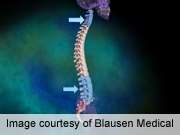(HealthDay)—Observational registry-based research can inform patients and physicians about prognosis for subacute or chronic neck or low back pain, according to a study published in the Aug. 1 issue of The Spine Journal.
Ana Royuela, from the Hospital Ramón y Cajal in Madrid, and colleagues analyzed data from a prospective registry of patients discharged after receiving a conservative treatment for subactue or chronic neck or low back pain (8,778 patients). Demographic, clinical, and work-related variables were included in a predictive model for each outcome (spinal pain, referred pain, and disability).
The researchers found that baseline scores for pain and disability, pain duration, having undergone X-ray, having undergone spine surgery, and receiving financial assistance for neck or low back pain had predictive value in the three models. There was a range from slight to moderate in the discrimination of the three models, and calibration was good.
"A registry in routine practice can be used to develop models that estimate the probability of improvement for each individual patient undergoing a specific form of treatment," the authors write.
More information:
Abstract
Full Text (subscription or payment may be required)
Journal information: Spine Journal
Copyright © 2014 HealthDay. All rights reserved.
























